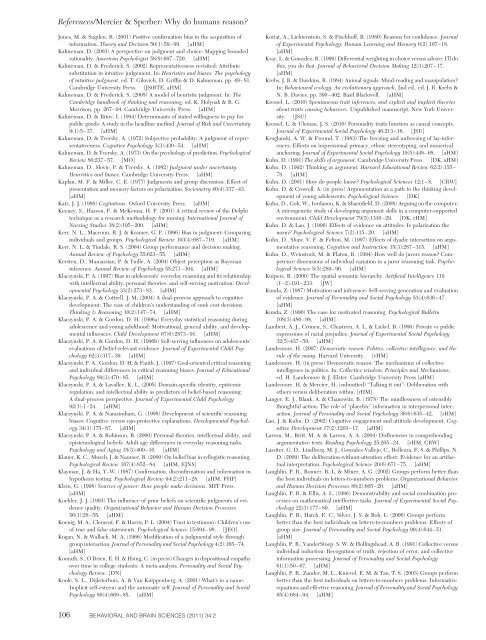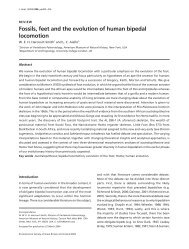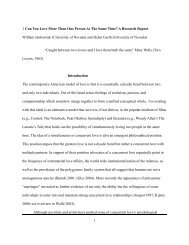Why do humans reason? Arguments for an argumentative theory
Why do humans reason? Arguments for an argumentative theory
Why do humans reason? Arguments for an argumentative theory
You also want an ePaper? Increase the reach of your titles
YUMPU automatically turns print PDFs into web optimized ePapers that Google loves.
References/Mercier & Sperber: <strong>Why</strong> <strong>do</strong> <strong>hum<strong>an</strong>s</strong> <strong>reason</strong>?Jones, M. & Sugden, R. (2001) Positive confirmation bias in the acquisition ofin<strong>for</strong>mation. Theory <strong>an</strong>d Decision 50(1):59–99. [aHM]Kahnem<strong>an</strong>, D. (2003) A perspective on judgment <strong>an</strong>d choice: Mapping boundedrationality. Americ<strong>an</strong> Psychologist 58(9):697–720. [aHM]Kahnem<strong>an</strong>, D. & Frederick, S. (2002) Representativeness revisited: Attributesubstitution in intuitive judgement. In: Heuristics <strong>an</strong>d biases: The psychologyof intuitive judgment, ed. T. Gilovich, D. Griffin & D. Kahnem<strong>an</strong>, pp. 49–81.Cambridge University Press. [JStBTE, aHM]Kahnem<strong>an</strong>, D. & Frederick, S. (2005) A model of heuristic judgment. In: TheCambridge h<strong>an</strong>dbook of thinking <strong>an</strong>d <strong>reason</strong>ing, ed. K. Holyoak & R. G.Morrison, pp. 267–94. Cambridge University Press. [aHM]Kahnem<strong>an</strong>, D. & Ritov, I. (1994) Determin<strong>an</strong>ts of stated willingness to pay <strong>for</strong>public goods: A study in the headline method. Journal of Risk <strong>an</strong>d Uncertainty9(1):5–37. [aHM]Kahnem<strong>an</strong>, D. & Tversky, A. (1972) Subjective probability: A judgment of representativeness.Cognitive Psychology 3(3):430–54. [aHM]Kahnem<strong>an</strong>, D. & Tversky, A. (1973) On the psychology of prediction. PsychologicalReview 80:237–57. [MO]Kahnem<strong>an</strong>, D., Slovic, P. & Tversky, A. (1982) Judgment under uncertainty:Heuristics <strong>an</strong>d biases. Cambridge University Press. [aHM]Kapl<strong>an</strong>, M. F. & Miller, C. E. (1977) Judgments <strong>an</strong>d group discussion: Effect ofpresentation <strong>an</strong>d memory factors on polarization. Sociometry 40(4):337–43.[aHM]Katz, J. J. (1986) Cogitations. Ox<strong>for</strong>d University Press. [aHM]Keeney, S., Hasson, F. & McKenna, H. P. (2001) A critical review of the Delphitechnique as a research metho<strong>do</strong>logy <strong>for</strong> nursing. International Journal ofNursing Studies 38(2):195–200. [aHM]Kerr, N. L., Maccoun, R. J. & Kramer, G. P. (1996) Bias in judgment: Comparingindividuals <strong>an</strong>d groups. Psychological Review 103(4):687–719. [aHM]Kerr, N. L. & Tindale, R. S. (2004) Group per<strong>for</strong>m<strong>an</strong>ce <strong>an</strong>d decision making.Annual Review of Psychology 55:623–55. [aHM]Kersten, D., Mamassi<strong>an</strong>, P. & Yuille, A. (2004) Object perception as Bayesi<strong>an</strong>inference. Annual Review of Psychology 55:271–304. [aHM]Klaczynski, P. A. (1997) Bias in a<strong>do</strong>lescents’ everyday <strong>reason</strong>ing <strong>an</strong>d its relationshipwith intellectual ability, personal theories, <strong>an</strong>d self-serving motivation. DevelopmentalPsychology 33(2):273–83. [aHM]Klaczynski, P. A. & Cottrell, J. M. (2004) A dual-process approach to cognitivedevelopment: The case of children’s underst<strong>an</strong>ding of sunk cost decisions.Thinking & Reasoning 10(2):147–74. [aHM]Klaczynski, P. A. & Gor<strong>do</strong>n, D. H. (1996a) Everyday statistical <strong>reason</strong>ing duringa<strong>do</strong>lescence <strong>an</strong>d young adulthood: Motivational, general ability, <strong>an</strong>d developmentalinfluences. Child Development 67(6):2873–91. [aHM]Klaczynski, P. A. & Gor<strong>do</strong>n, D. H. (1996b) Self-serving influences on a<strong>do</strong>lescents’evaluations of belief-relev<strong>an</strong>t evidence. Journal of Experimental Child Psychology62(3):317–39. [aHM]Klaczynski, P. A., Gor<strong>do</strong>n, D. H. & Fauth, J. (1997) Goal-oriented critical <strong>reason</strong>ing<strong>an</strong>d individual differences in critical <strong>reason</strong>ing biases. Journal of EducationalPsychology 89(3):470–85. [aHM]Klaczynski, P. A. & Lavallee, K. L. (2005) Domain-specific identity, epistemicregulation, <strong>an</strong>d intellectual ability as predictors of belief-based <strong>reason</strong>ing:A dual-process perspective. Journal of Experimental Child Psychology92(1):1–24. [aHM]Klaczynski, P. A. & Narasimham, G. (1998) Development of scientific <strong>reason</strong>ingbiases: Cognitive versus ego-protective expl<strong>an</strong>ations. Developmental Psychology34(1):175–87. [aHM]Klaczynski, P. A. & Robinson, B. (2000) Personal theories, intellectual ability, <strong>an</strong>depistemological beliefs: Adult age differences in everyday <strong>reason</strong>ing tasks.Psychology <strong>an</strong>d Aging 15(3):400–16. [aHM]Klauer, K. C., Musch, J. & Naumer, B. (2000) On belief bias in syllogistic <strong>reason</strong>ing.Psychological Review 107(4):852–84. [aHM, EJNS]Klaym<strong>an</strong>, J. & Ha, Y.-W. (1987) Confirmation, disconfirmation <strong>an</strong>d in<strong>for</strong>mation inhypothesis testing. Psychological Review 94(2):211–28. [aHM, FHP]Klein, G. (1998) Sources of power: How people make decisions. MIT Press.[aHM]Koehler, J. J. (1993) The influence of prior beliefs on scientific judgments of evidencequality. Org<strong>an</strong>izational Behavior <strong>an</strong>d Hum<strong>an</strong> Decision Processes56(1):28–55. [aHM]Koenig, M. A., Clement, F. & Harris, P. L. (2004) Trust in testimony: Children’s useof true <strong>an</strong>d false statements. Psychological Science 15:694–98. [JEO]Kog<strong>an</strong>, N. & Wallach, M. A. (1966) Modification of a judgmental style throughgroup interaction. Journal of Personality <strong>an</strong>d Social Psychology 4(2):165–74.[aHM]Konrath, S., O’Brien, E. H. & Hsing, C. (in press) Ch<strong>an</strong>ges in dispositional empathyover time in college students: A meta-<strong>an</strong>alysis. Personality <strong>an</strong>d Social PsychologyReview. [DN]Koole, S. L., Dijksterhuis, A. & V<strong>an</strong> Knippenberg, A. (2001) What’s in a name:Implicit self-esteem <strong>an</strong>d the automatic self. Journal of Personality <strong>an</strong>d SocialPsychology 80(4):669–85. [aHM]Koriat, A., Lichtenstein, S. & Fischhoff, B. (1980) Reasons <strong>for</strong> confidence. Journalof Experimental Psychology: Hum<strong>an</strong> Learning <strong>an</strong>d Memory 6(2):107–18.[aHM]Kray, L. & Gonzalez, R. (1999) Differential weighting in choice versus advice: I’ll <strong>do</strong>this, you <strong>do</strong> that. Journal of Behavioral Decision Making 12(3):207–17.[aHM]Krebs, J. R. & Dawkins, R. (1984) Animal signals: Mind-reading <strong>an</strong>d m<strong>an</strong>ipulation?In: Behavioural ecology: An evolutionary approach, 2nd ed., ed. J. R. Krebs &N. B. Davies, pp. 390–402. Basil Blackwell. [aHM]Kressel, L. (2010) Spont<strong>an</strong>eous trait inferences, <strong>an</strong>d explicit <strong>an</strong>d implicit theoriesabout traits causing behaviors. Unpublished m<strong>an</strong>uscript, New York University.[JSU]Kressel, L. & Ulem<strong>an</strong>, J. S. (2010) Personality traits function as causal concepts.Journal of Experimental Social Psychology 46:213–16. [JSU]Krugl<strong>an</strong>ski, A. W. & Freund, T. (1983) The freezing <strong>an</strong>d unfreezing of lay-inferences:Effects on impressional primacy, ethnic stereotyping, <strong>an</strong>d numerical<strong>an</strong>choring. Journal of Experimental Social Psychology 19(5):448–68. [aHM]Kuhn, D. (1991) The skills of argument. Cambridge University Press. [DK, aHM]Kuhn, D. (1992) Thinking as argument. Harvard Educational Review 62(2):155–78. [aHM]Kuhn, D. (2001) How <strong>do</strong> people know? Psychological Sciences 12:1–8. [CRW]Kuhn, D. & Crowell, A. (in press) Argumentation as a path to the thinking developmentof young a<strong>do</strong>lescents. Psychological Science. [DK]Kuhn, D., Goh, W., Iord<strong>an</strong>ou, K. & Shaenfield, D. (2008) Arguing on the computer:A microgenetic study of developing argument skills in a computer-supportedenvironment. Child Development 79(5):1310–29. [DK, rHM]Kuhn, D. & Lao, J. (1996) Effects of evidence on attitudes: Is polarization thenorm? Psychological Science 7(2):115–20. [aHM]Kuhn, D., Shaw, V. F. & Felton, M. (1997) Effects of dyadic interaction on <strong>argumentative</strong><strong>reason</strong>ing. Cognition <strong>an</strong>d Instruction 15(3):287–315. [aHM]Kuhn, D., Weinstock, M. & Flaton, R. (1994) How well <strong>do</strong> jurors <strong>reason</strong>? Competencedimensions of individual variation in a juror <strong>reason</strong>ing task. PsychologicalScience 5(5):289–96. [aHM]Kuipers, B. (2000) The spatial sem<strong>an</strong>tic hierarchy. Artificial Intelligence 119(1–2):191–233. [JW]Kunda, Z. (1987) Motivation <strong>an</strong>d inference: Self-serving generation <strong>an</strong>d evaluationof evidence. Journal of Personality <strong>an</strong>d Social Psychology 53(4):636–47.[aHM]Kunda, Z. (1990) The case <strong>for</strong> motivated <strong>reason</strong>ing. Psychological Bulletin108(3):480–98. [aHM]Lambert, A. J., Cronen, S., Chasteen, A. L. & Lickel, B. (1996) Private vs publicexpressions of racial prejudice. Journal of Experimental Social Psychology32(5):437–59. [aHM]L<strong>an</strong>demore, H. (2007) Democratic <strong>reason</strong>: Politics, collective intelligence, <strong>an</strong>d therule of the m<strong>an</strong>y. Harvard University. [rHM]L<strong>an</strong>demore, H. (in press) Democratic <strong>reason</strong>: The mech<strong>an</strong>isms of collectiveintelligence in politics. In: Collective wis<strong>do</strong>m: Principles <strong>an</strong>d Mech<strong>an</strong>isms,ed. H. L<strong>an</strong>demore & J. Elster. Cambridge University Press [aHM]L<strong>an</strong>demore, H. & Mercier, H. (submitted) “Talking it out”: Deliberation withothers versus deliberation within. [rHM]L<strong>an</strong>ger, E. J., Bl<strong>an</strong>k, A. & Ch<strong>an</strong>owitz, B. (1978) The mindlessness of ostensiblythoughtful action: The role of “placebic” in<strong>for</strong>mation in interpersonal interaction.Journal of Personality <strong>an</strong>d Social Psychology 36(6):635–42. [rHM]Lao, J. & Kuhn, D. (2002) Cognitive engagement <strong>an</strong>d attitude development. CognitiveDevelopment 17(2):1203–17. [aHM]Larson, M., Britt, M. A. & Larson, A. A. (2004) Disfluencies in comprehending<strong>argumentative</strong> texts. Reading Psychology 25:205–24. [rHM, CRW]Lassiter, G. D., Lindberg, M. J., Gonzalez-Vallejo, C., Bellezza, F. S. & Phillips, N.D. (2009) The deliberation-without-attention effect: Evidence <strong>for</strong> <strong>an</strong> artifactualinterpretation. Psychological Science 20(6):671–75. [aHM]Laughlin, P. R., Bonner, B. L. & Miner, A. G. (2002) Groups per<strong>for</strong>m better th<strong>an</strong>the best individuals on letters-to-numbers problems. Org<strong>an</strong>izational Behavior<strong>an</strong>d Hum<strong>an</strong> Decision Processes 88(2):605–20. [aHM]Laughlin, P. R. & Ellis, A. L. (1986) Demonstrability <strong>an</strong>d social combination processeson mathematical intellective tasks. Journal of Experimental Social Psychology22(3):177–89. [aHM]Laughlin, P. R., Hatch, E. C., Silver, J. S. & Boh, L. (2006) Groups per<strong>for</strong>mbetter th<strong>an</strong> the best individuals on letters-to-numbers problems: Effects ofgroup size. Journal of Personality <strong>an</strong>d Social Psychology 90(4):644–51.[aHM]Laughlin, P. R., V<strong>an</strong>derStoep, S. W. & Hollingshead, A. B. (1991) Collective versusindividual induction: Recognition of truth, rejection of error, <strong>an</strong>d collectivein<strong>for</strong>mation processing. Journal of Personality <strong>an</strong>d Social Psychology61(1):50–67. [aHM]Laughlin, P. R., Z<strong>an</strong>der, M. L., Knievel, E. M. & T<strong>an</strong>, T. S. (2003) Groups per<strong>for</strong>mbetter th<strong>an</strong> the best individuals on letters-to-numbers problems: In<strong>for</strong>mativeequations <strong>an</strong>d effective <strong>reason</strong>ing. Journal of Personality <strong>an</strong>d Social Psychology85(4):684–94. [aHM]106 BEHAVIORAL AND BRAIN SCIENCES (2011) 34:2




